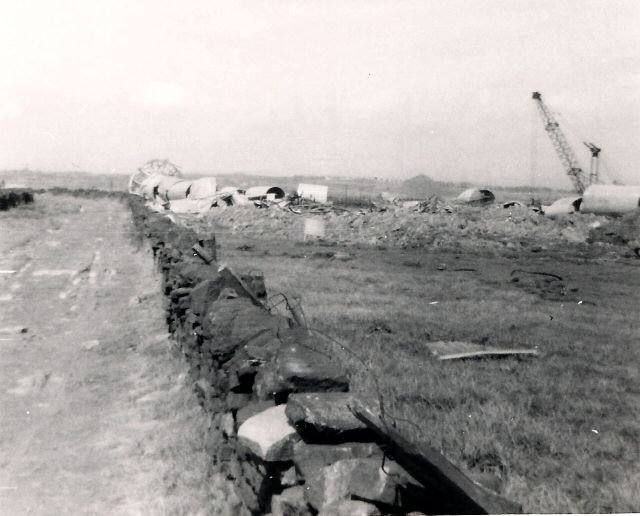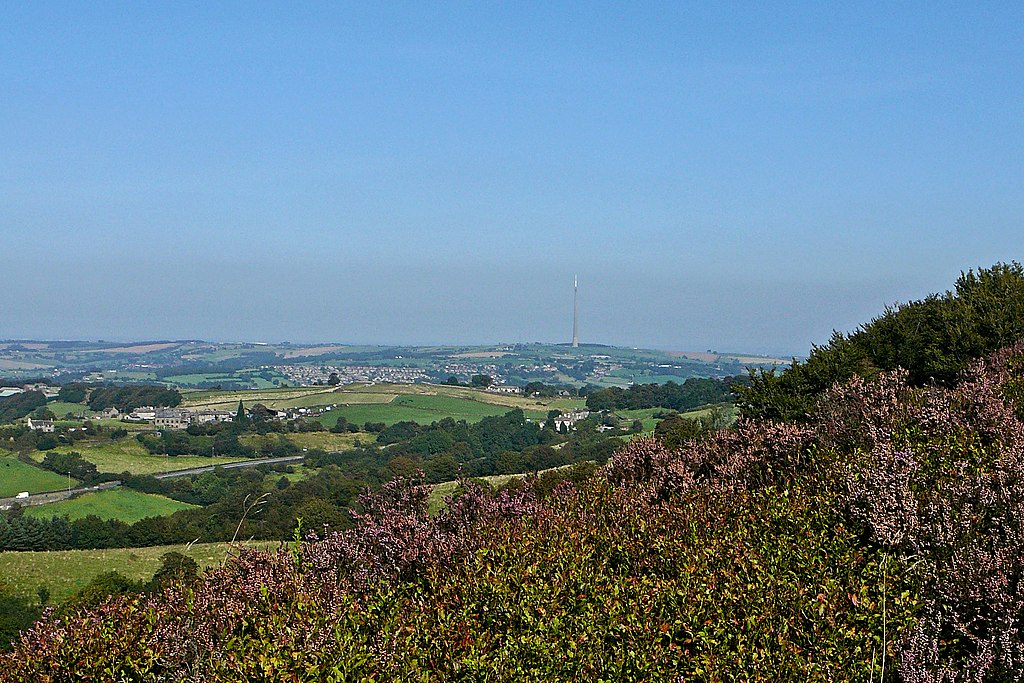Public TV for the North of England
Although the BBC had been broadcasting television since the 1930s, it wasn’t until 1951 that the first television transmitter for the north of England was built at Holme Moss, operated by the BBC. Soon after, commercial television was authorized, and the new Independent Television Authority (ITA) built a transmitter at Emley Moor in 1956 to serve Yorkshire. Emley Moor broadcast Granada TV during the week and ABC TV at weekends, using the same 405-line monochrome system as the BBC.

By 1966 colour TV was appearing on the scene, and the mast was replaced to improve reception in outlying areas and accommodate 625-line UHF colour transmissions. The new mast was a 365-metre cylindrical structure supported by steel cable guys, and provided transmission for both ITA and BBC2 programmes. From the outset, the weather caused problems – the structure froze in winter and occasionally local roads had to be closed because of the falling ice hazard.
Despite this, Yorkshire Television began broadcasting from the Emley Moor transmitter in July 1968, from their new studios on Kirkstall Road in Leeds.
Disaster strikes: 19 March 1969
Just after 5pm on 19 March 1969, after ice had been falling during the afternoon, the mast collapsed without warning. The accumulation of ice was believed to be the cause, but a committee of inquiry attributed it to a form of oscillation which occurred at a low but steady wind speed. Modifications were made to similar masts, including hanging 150 tons of steel chains within each structure, and no others failed after that.
The collapse at Emley Moor left wreckage over the transmitter site, across nearby roads and in surrounding fields. A falling stay cable cut through a local church and across the transmitter site buildings—but thankfully no one was injured. The accident completely disabled the BBC2 UHF transmitter and the ITV VHF transmitter, leaving several million people without service, although BBC1 VHF television transmissions continued from Holme Moss.

So what was next? New masts had to be found and broadcasting restored. Yorkshire Television was a new company and couldn’t afford to lose its advertising revenue for long, so the pressure was on the ITA and BBC to find solutions. They were going to be busy, but so too was the Post Office.
At the time I was Network Coordinator at Post Office Telecommunications North Eastern Region. When I arrived home on the evening of the incident, the phone had been hot for an hour. I was mentally stunned with possible scenarios. First, I called the Post Office Television Network Switching Centre in Leeds. Apparently falling ice had been a problem all afternoon, because it kept striking the PO dish aerials on the tower, degrading transmission before the full collapse. I then called the National Network Control Centre in London. The controller answered, a lovely man with a cultured voice and a firm but quiet manner. He said, “Good evening David, I thought you would be calling. Look at the options for restoring service. Let me have your proposals tomorrow—good night” A good night? Yeah, right!
Getting TV back on air
The Post Office had to restore the microwave radio systems that brought the programmes into Emley Moor from the Yorkshire Television and BBC 2 studios. The receiving aerials had been situated part way up the mast and had been lost in the collapse. The problem was made more difficult because the surrounding landscape meant incoming signals could not be received at ground level. A solution was needed that allowed programmes to be beamed into the Emley Moor site close to ground level.
Urgent propagation tests were executed by a Post Office TV Outside Broadcast team between Upton radio station near Pontefract and the roof of the Post Office building at Emley Moor. These tests were successful, but Upton was a repeater station—an automated station that extends the range of communication. Fortunately, it was equipped with a service protection channel that had sufficient bandwidth to carry a 625 line UHF television signal, and this was used to carry the Yorkshire Television programmes from Leeds and the BBC 2 programmes from London. By the morning of Saturday 22 March 1969 the work was complete, and I was delighted and relieved that the Post Office could offer the programme signals to ITA and BBC before they had new temporary masts in place to start broadcasting.
All parties got to work on the problem quickly. The ITA owned a 61-metre collapsible emergency mast, which was moved to Emley from the Lichfield transmitting station so that some service could be restored. ITV signals were restored to 2.5 million viewers within four days. The BBC provided a mobile mast on an outside broadcast van to restore a restricted BBC2 colour service within three days. The ITA bought a larger temporary mast from the Swedish air force. A crew of Polish riggers were hired, and a 204-metre mast was erected in under 28 days. This mast could hold only one set of antennae, so many viewers in outlying areas still could not receive colour programmes. The taller mast was brought into service on 16 April and some weeks later the BBC erected a 91-metre mast, improving coverage.
Building a new transmitter: An engineering feat
A series of improved temporary masts followed, but locals didn’t like the idea of another mast on the moor, and so a new design was called for. The current concrete tower was an Arup design and construction began later in 1969. A 330-metre reinforced concrete tower with an antenna at the top, it’s the tallest freestanding structure in the United Kingdom. It takes a seven-minute journey by lift to reach the tower room at the top (274 metres high), and the antenna structure is a further 56 metres high. The mast’s foundations penetrate 6 metres into the ground, and including foundations, the whole structure weighs 11,200 tonnes.

UHF (625-line colour) transmissions commenced on 21 January 1971, and the older VHF (405-line black & white) system became operational on 21 April 1971. After a dramatic start, television and radio are still transmitted from Emley Moor, and the tower itself is a Grade II listed building for its “significant architectural or historic interest”.
As a young man I emigrated to Australia in January 1969 and lived there for over 40 years. After being back in the UK now for 12 years and not really knowing much about the original mast, I was highly delighted to read about it’s history, which was well presented and very imformative.
Thank you
I came home from work and told my Mrs that Emley Moor had collapsed.She replied “oh dear, is she Ok”.